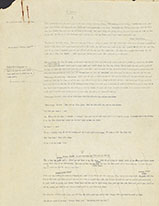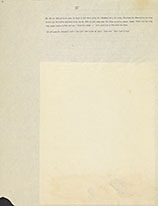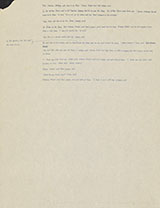Manuscripts Etc.
| CLOSE WINDOW |

|
The following items are drawn from the William Faulkner Foundation Collection at the University of Virginia's Albert and Shirley Small Special Collections Library (http://small.library.virginia.edu/). |
|
Faulkner began writing "A Justice" sometime soon after "Red Leaves," his first story about the tribe of Indians who inhabit Yoknapatawpha before the white settlers arrive. A version of it was finished by the end of November, 1930; according to Faulkner's own hand-written record, that was when he submitted the story - titled "Indians Built a Fence" - to the Saturday Evening Post. By 3 March 1931 it had been retitled "A Justice," and was submitted under that title to Harper's Magazine. In between those dates he sent it to at least three other periodicals, but none accepted it for publication. The manuscript that survives is clearly a composite of several versions he wrote over at least some months. The first page (below left) bears the newer title, but other pages are on different kinds of paper and some include passages cut from earlier versions and pasted into a revised one (see page 3, below right). Faulkner tore off the upper lefthand corner - where he put page numbers - from every page, making it much harder to put them in a chronological sequence. We can't see how much, or much about how, the story changed between its earliest and its final form. The manuscript, however, does indicate some of the places where Faulkner struggled to tell the story. As narrator, Quentin indicates the problem Sam Fathers faced when, in the second paragraph of the first page below, he says that Sam "wasn't a negro." His next words - "That's what I'm going to tell about" - point directly to race as the vexed subject of the story. Even after he had revised the text at least several times, Faulkner was still figuring out how he wanted to frame that issue. You can see that struggle for yourself in the revisions he made in the second and third paragraphs, where Quentin explains what black and white people "call" Sam, and then describes the way he himself sees Sam. Faulkner also changed his mind about who should tell Sam the story that Sam tells Quentin. The cancelled section "II" at the bottom of page 1 first gives that role to Sam's "pappy," - his biological father, the Indian who took his enslaved mother as a kind of concubine. The fact that by the time he wrote page 2 (below center) the source has changed to Herman Basket suggests that this second page might have been written some time after the first.
   Below left: This unfinished beginning for the story's section III appears on the back of the third manuscript page. Faulkner typically did not write on both sides of a piece of paper, though to save money he did often turn over and re-use pages that he had discarded after writing on them. It is unclear, however, how the back of a discarded page numbered 4 became the front of the manuscript's third page; this is another elusive aspect of the composition history of this text. Below center: The fourth manuscript page contains the end of section II, almost exactly as it appears in the published story. Below right: On the back of the final page 4 is a false start on a page numbered "4." As in a cancelled passage at the very bottom of the third page (above right), Doom begins giving a eulogy at the funeral of the Man's young son, whom he has murdered along with his father; giving such a speech would put Doom in good company, or at least the company of some of Shakespeare's greatest villains, but Faulkner chose not to include it in the story.
   Citing this source: |
